Some late-night photographic fun. It seems amazing now that I thought some of my previous cars were good, despite a total absence of blue LEDs.
Category Archives: Electric Vehicles
The next step?
If I had the money (which I don’t), don’t you think I should get one of these as my next bit of electrically-powered transport?
More info, including videos, here. I think a boathouse on the shores of Lake Como, with solar panels on the roof, don’t you?
My first electric fortnight
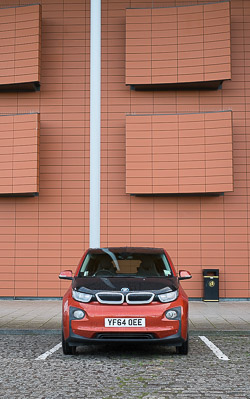 Well, I’m just over two weeks into the world of electric car ownership, and enjoying it very much so far.
Well, I’m just over two weeks into the world of electric car ownership, and enjoying it very much so far.
I’ve driven about 400 miles in my i3, and since some proportion of my charging has been at free public charging points, the ‘fuel’ cost to me so far has been about 4 quid. If you conveniently ignore the enormous purchase price and future depreciation of an almost-new BMW, the cost of actually running an electric car is less than going by bus, a lot less than using traditional car, and phenomenally cheap when compared to a train.
What I didn’t realise, though, when I first started this, was that I was taking on a hobby as well. There are many reasons why people buy electric cars (and here I’m talking about purely- or predominantly-battery-powered, rather than hybrids). I think a large group — the relatively silent majority — buy, say, a Nissan Leaf or a Renault Zoe as a second car, charge it in their driveway each night, and use it for all their around-town day-to-day stuff, but rely on the Volvo diesel for going on holiday or for anything much beyond the range of a single charge. That, at present, is an exceedingly sensible use of an electric vehicle.
Then there are people like me. Some of us are tree-huggers. Some are gadget enthusiasts. But we feel like real pioneers because life is a bit harder out there on the frontier. We depend much more, perhaps entirely, on our batteries. We know acronyms that you don’t know. We measure efficiency in miles-per-kWh. We understand how best to handle the chaos that is the current public charging infrastructure, and we know when the charging stations at Leicester Forest East or South Mimms are out of action. In short, it’s an enthusiasts’ club, and it reminds me more than anything of the days in my youth when I used to go sailing, or caravanning, or hang-gliding; when people with beards would gather in out-of-the-way places to discuss windspeeds, safe harbours, and the various cunning hacks they’ve made to their equipment, or their lifestyles, to allow them to pursue this interest more effectively. It’s actually a big part of the fun. Most of these communities are now on Facebook or other forums, of course, and they are exceedingly good-natured and informative. One completely unexpected change for me is that I now consult Facebook once or twice a day because it actually contains stuff that interests me — in the past I seldom ever looked at it except in response to messages or comments from others. And it’s fun that there are occasional real-life meetups too, like the one I visited last month.
Unlike hobbies such as sailing, or classic-car restoration, though, this really is pioneering, in the sense that what we’re doing is clearly anticipating the future and trying to live in it a bit earlier than is perhaps sensible. In my case, for example, I don’t have off-street parking, so I have to jump through some hoops to charge in the street without inconveniencing my neighbours. And since my outdoor fast charging socket won’t be installed for another week or so, I currently refuel my car by running an extension lead through my letter box a couple of times a week! This seems like a hassle, but it actually takes less time than visiting those big smelly petrol stations I remember from the past. If I were really sentimental, it might occur to me that my cute little car prefers coming back in the evening for comfort and refreshment at home, rather than going to one of those brightly-coloured flashy bars that some other cars go to, where the drinks are so expensive. But I’m not that soppy, so it didn’t occur to me at all.
My situation does highlight a challenge that governments are going to have to face soon, though: the places that will benefit most from electric vehicles are the cities, which are also the places where the smallest proportion of residents will be able to charge at home. I think a key part of making this work will be ensuring plentiful opportunities for occasional casual charging in car parks, on the street, at businesses, cafes, pubs and supermarkets. We need to start thinking about a power infrastructure that allows the majority of parking places at your local Tesco to provide a few kilowatts, rather than just one or two specially-marked spots in the corner.
And the i3 is proving an interesting venture for BMW, too. Whether it’s a financial success overall remains to be seen, but articles like this one yield some intriguing statistics: more than 80% of BMW i3 buyers worldwide have not been BMW customers before, for example, (including me), and in Norway (where almost all electricity is from renewable sources), the i3 is the best-selling BMW across the entire range…
Anyway, going back to my original thread, you might point out that claims of being a hardy pioneer are a bit rich coming from someone with nice heated leather seats in his BMW. And you would be right. There are others who have been doing this for years, in less capable vehicles, and who depend on it for a daily commute. I cannot even claim to have cut the fossil-fuel umbilical cord completely because my car does have a ‘range-extender’ – a small built-in generator in the back with a couple of gallons of petrol, which can maintain the battery charge at its current level in situations when charging really isn’t an option. The i3 is not really a hybrid, it’s an electric car with an optional safety net accessory – something to get us through the next five or ten years while the charging infrastructure solidifies – and in my case, something which allows me to consider an electric vehicle as our only car. I haven’t actually used the range extender yet, except for demonstrating it briefly to friends, so I can still use a nice phrase I saw online recently: “It’s good to get my MPG back into four figures.” No, my only real claim to hardship at present is in the sudden and rather dramatic change in my bank balance, comparable to if I had decided to buy a modest boat or motorhome.
What I’d really like to do is follow the example of some EV enthusiasts who charge their cars primarily from solar, and can claim to drive around the country powered only by sunshine. But that would involve moving house to something with off-street parking and a roof facing in the right direction. No. Not yet. But as I was ticking off the miles cruising home in comfort down the motorway at 70mph yesterday night in the rain, it did occur to me that even this was a quite remarkable ability to have achieved from that little cable I occasionally run through my letterbox.
You see why we’re enthusiasts?
Gone with the wind
Here’s my new toy, charging up at the Birchanger Green service station on the M11 yesterday.
Now, I’m no eco-warrior, but it’s very satisfying to think that the great majority of the 250-or-so miles I’ve driven in it so far have been powered by wind, thanks to Ecotricity.
And the total fuel cost to me has been under £1 so far. (I topped it up at home one night.)
Also, it has cool doors!
Best. Gadget. Yet.
On Thursday evening I got a new mobile device, and this time it wasn’t from Apple.
It has two displays, a variety of inputs, front and rear cameras, GPS tracking, and remarkably good audio output. The internet connectivity is built in; I guess there’s an embedded SIM somewhere but I don’t have to worry about it. It has a touchpad, and reasonable speech recognition.
All of this takes a fair amount of power, so it has a largish charging cable – it’s one of the few mobile gadgets I’ve bought recently which can’t be charged via USB. This is inconvenient, but I’m working out ways to deal with it.
Anyway, all in all, it’s great fun, and there’s a software update coming out sometime in the next couple of weeks which should make it even better.
Oh, and here’s a photo.
Thinking electric

I’ve been test-driving electric and hybrid cars recently. I’ve tried the all-electric Renault Zoe and Nissan Leaf, and the plug-in hybrid Golf GTE. All of these are excellent cars, and a pleasure to drive. I’d recommend anyone thinking of a second car to have a look at them; a used Zoe with very few miles on the clock will set you back about £8000, and since Renault have a battery-leasing scheme you need to add about £4000 to that if you keep the car for five years. I enjoyed driving it. The Leaf is even better, but a bit bigger and more expensive – it’s a really nice car. The manufacturers have gone out of their way to make sure that driving one of these has as few surprises as possible for anyone used to any other vehicle. We’re thinking about a replacement for our main car, though, and we’re not quite ready to go all-electric for that. In 5 years’ time, that will be completely viable, but not yet, not for us.
So, ever since I heard first about the Golf GTE, I thought that might be the answer. Our current Golf has been probably the best car I’ve owned, the local dealer is very good, and this would let us venture into the hybrid/electric world while keeping our feet safely on the ground. And VW have some very nice extras like automatic parallel parking, and a good adaptive cruise control. When people talk about cruise controls I tend to think about motorway driving, but what’s possibly even cooler is its ability to keep you a constant distance from the car in front while crawling through slow-moving traffic. I really liked that.
But there’s a problem.
The problem is that in the middle of this process, I drove the BMW i3. For those of you not acquainted with the i3, it’s an electric car designed from the ground-up, built with various lightweight, innovative (and often recycled) materials, in a factory powered almost entirely by renewable energy, and so on. It’s quirky, and great fun, though it also comes with a BMW price tag. Ouch. Still, there are some used ones available now, and at least it’s not a Tesla.
But the i3 has an optional extra that almost everybody buys: the range-extender (known to the cognoscenti as the ‘REx’). This is a little 30HP 600cc engine tucked away below the boot which can charge the battery from a two-gallon petrol tank and extend the roughly 90 miles of normal electric range for another 90 miles, or, in fact, for as far as you like if you don’t mind stopping to fill up every hour and a half! So I could, if wanted, drive from here to the Lake District in the opposite corner of Britain with just a couple of stops even if all the (increasingly plentiful) electric charging points en route were full or inoperative.
So it’s not a true hybrid, in the sense that the engine is never intended to be the main thing driving the car. In fact, many owners use the REx so rarely that the car will switch it on briefly every few hundred miles just to keep it happy. But, for me, it’s the thing that lets you have an innovative and almost all-electric car and yet bridge the next few years until the charging infrastructure is more fully developed. And after driving it, other hybrids like the Golf seem, well, rather compromised: packing two full engines into a car that therefore only has an electric range of around 30 miles, when the 90 electric miles or so available from a more thoroughly-electric car would almost cover me for a typical week on a single charge. (This may be important, since I have no off-street parking at home.)
I like living in the future – or at least, trying to. (Shaw was right.) Even Rose, who’s an historian and likes living in the past, can see the attraction of this. Imagine you’re thinking of buying a boat. The sensible thing to get is a motor yacht, because it can go anywhere in almost any weather. But it’s so much more romantic, and beautiful, and pioneering, and quiet, and environmentally friendly, to get something with sails instead, even if you then have to plan a little bit more about where you can go, and when. Well, this is a sailing boat, but with an outboard motor, for when you need it, but with the added interesting twist that it can out-accelerate almost any other speedboat in the harbour.
So yesterday I went (with my friends Michael and Laura, who have one) to a gathering of i3 owners near Milton Keynes to find out more. There were about 34 i3s there, and a couple of i8s, which means the combined battery capacity was approaching a megawatt-hour. Your physics assignment for this morning is to work out what kind of fun things you could do if, say, you discharged all of that over five or ten minutes. (I’m thinking about, for example, using some wind-turbines as fans…)
It was a happy gathering despite the yucky grey weather, and some very helpful, knowledgeable and cheery BMW staff had turned up from the North Oxford dealership (thanks, guys!) even though they probably guessed they weren’t going to make many sales, since everybody but me already had one!
Still, who knows, they might make one more sale before too long…
© Copyright Quentin Stafford-Fraser
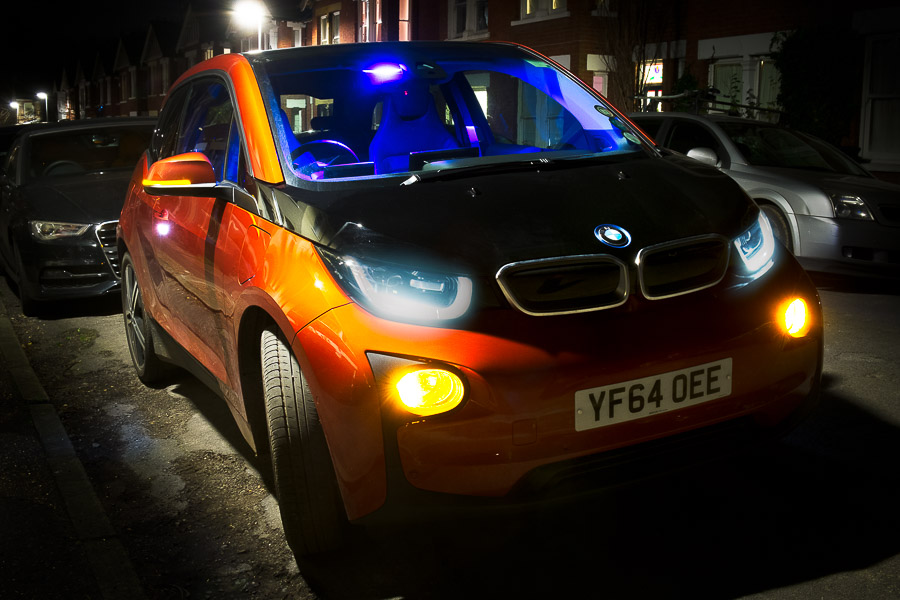

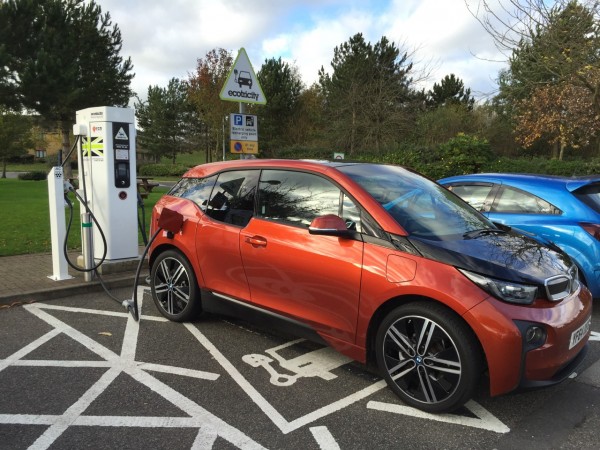
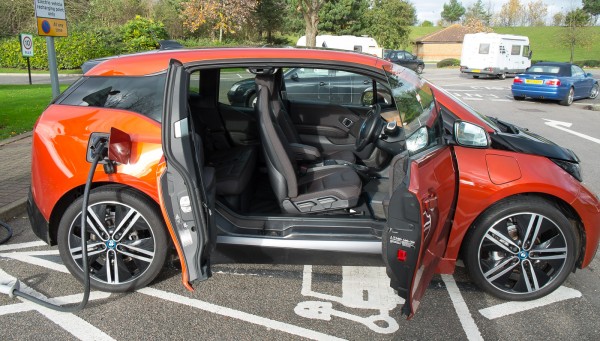

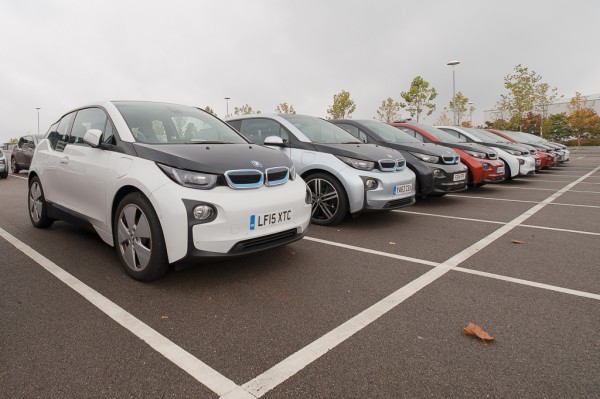
Recent Comments